Project 1: Glowing Flower Pot
This project revolves around creating a flower pot that glows LED light based on human interaction. Below is a step-by-step on how to create it.
Everything I used:
- 1 LED Bulb/light
- 1 coin battery
- conductive tape(copper tape can be used as well)
- scotch tape
- 1 stainless steel brush
- 1 popsicle stick
- coffee filters (~5)
- 1 cupcake holder
- several markers(if you want to decorate your coffee filter)
- one plastic tape to secure everything firmly
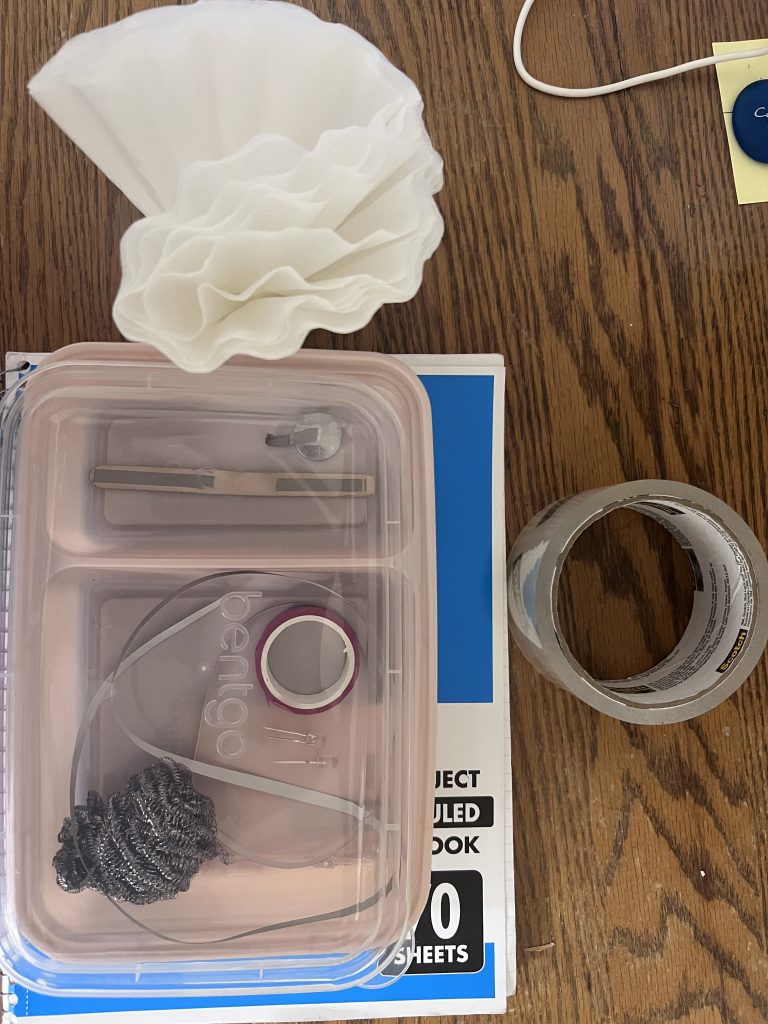
Step-by-Step Guide:
- Building a simple circuit:
- Firstly, we will lay one strip of conductive tape on one side of the popsicle stick and 2 strip divided in two on the other side of the stick.
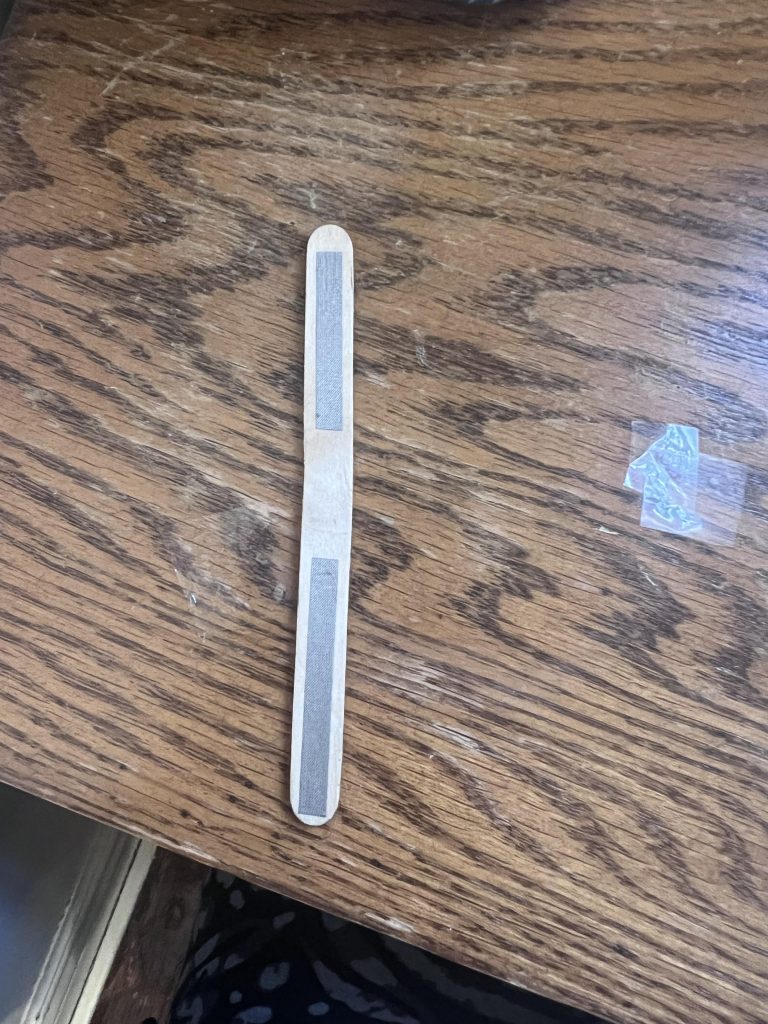
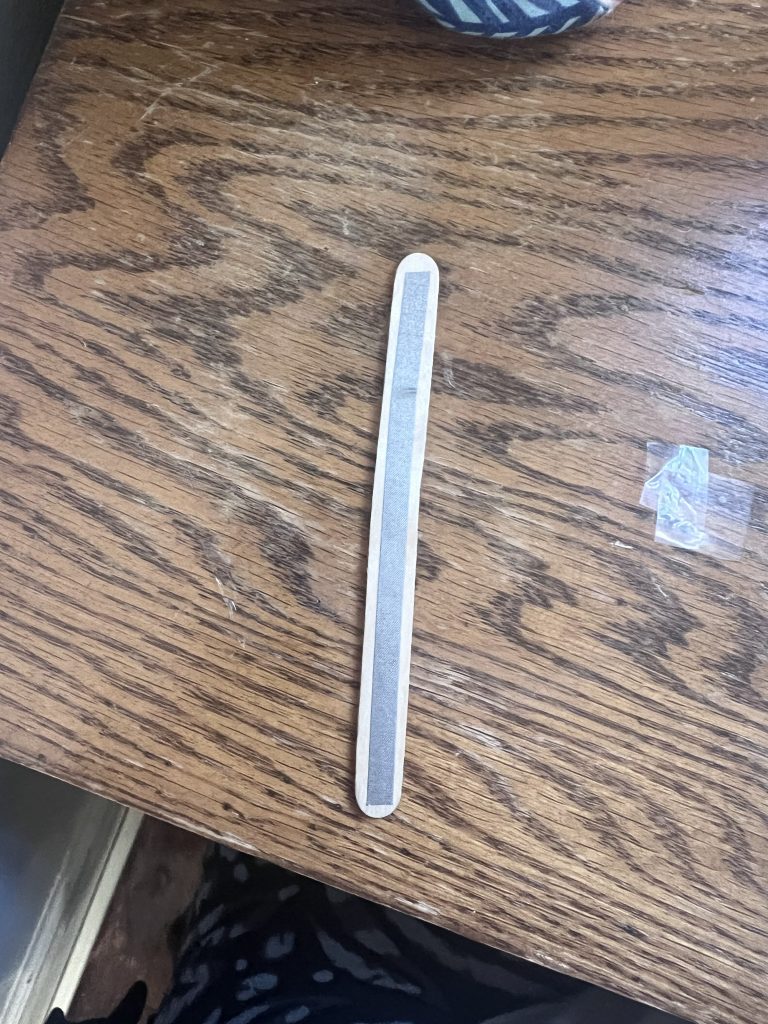
2.Below I’ve provided a basic diagram of the circuit we are trying to build:
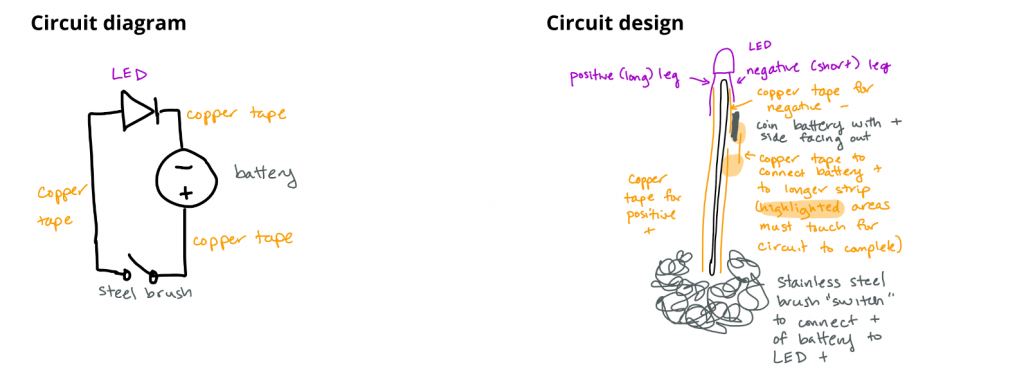
a. In the side of the stick where the tape is divided into two side, we will place the battery on one side of the tape and use another piece of the tape to attach it to the half of the tape on the same side of the stick.
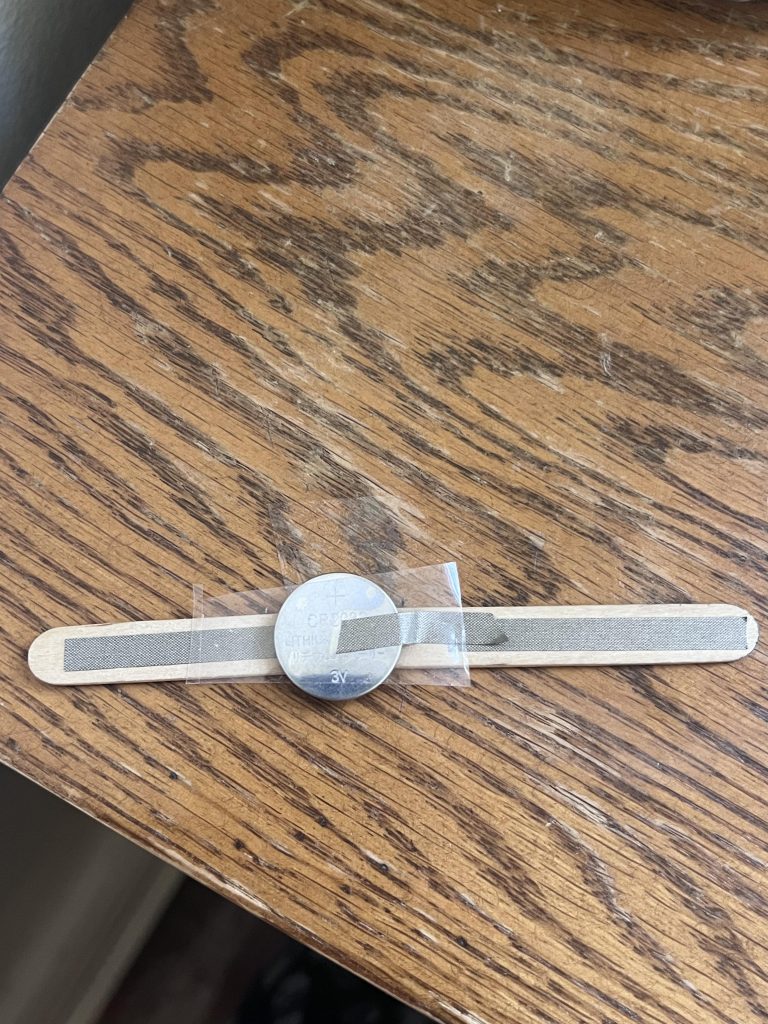
b. Now that the battery is firmly placed, we will put the led light at the top of the stick where the short leg of the LED(negative side) will be facing the battery and the long side of the LED will be facing the back side of the battery. After that we will be using scotch tape to secure everything tightly onto the stick and tape so that electricity can flow freely. If they are not tightly secure using tape, it doesn’t work. I had to use to layer of taping one using scotch tape and another layer of plastic duct tape to secure the LED in place.
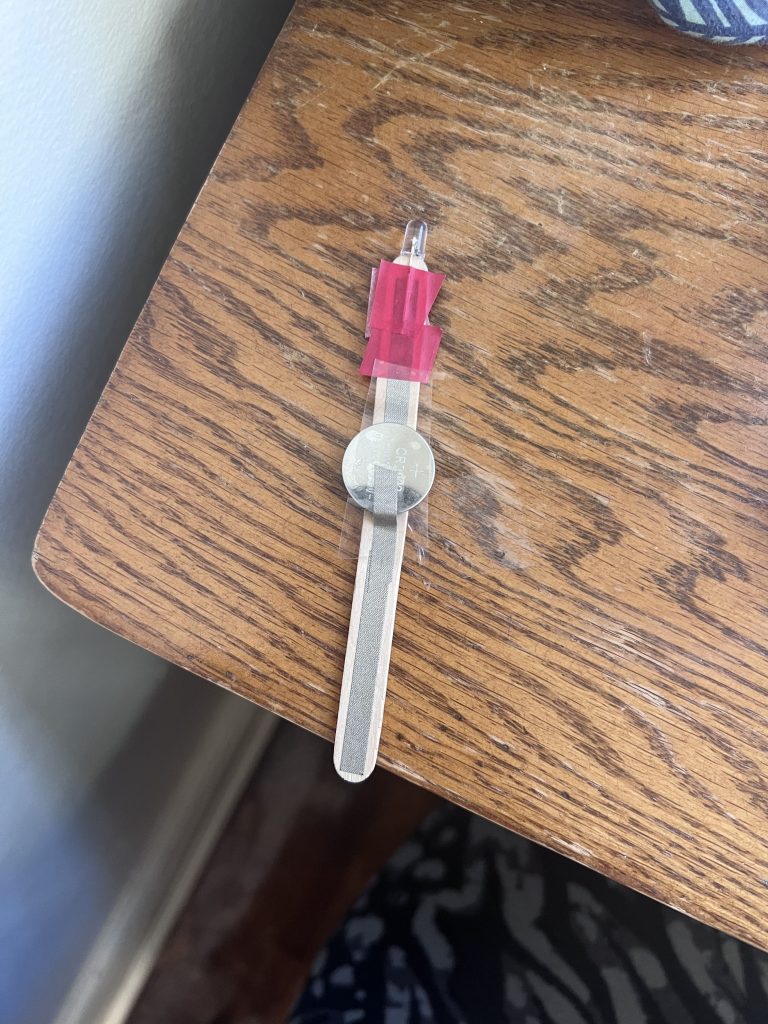
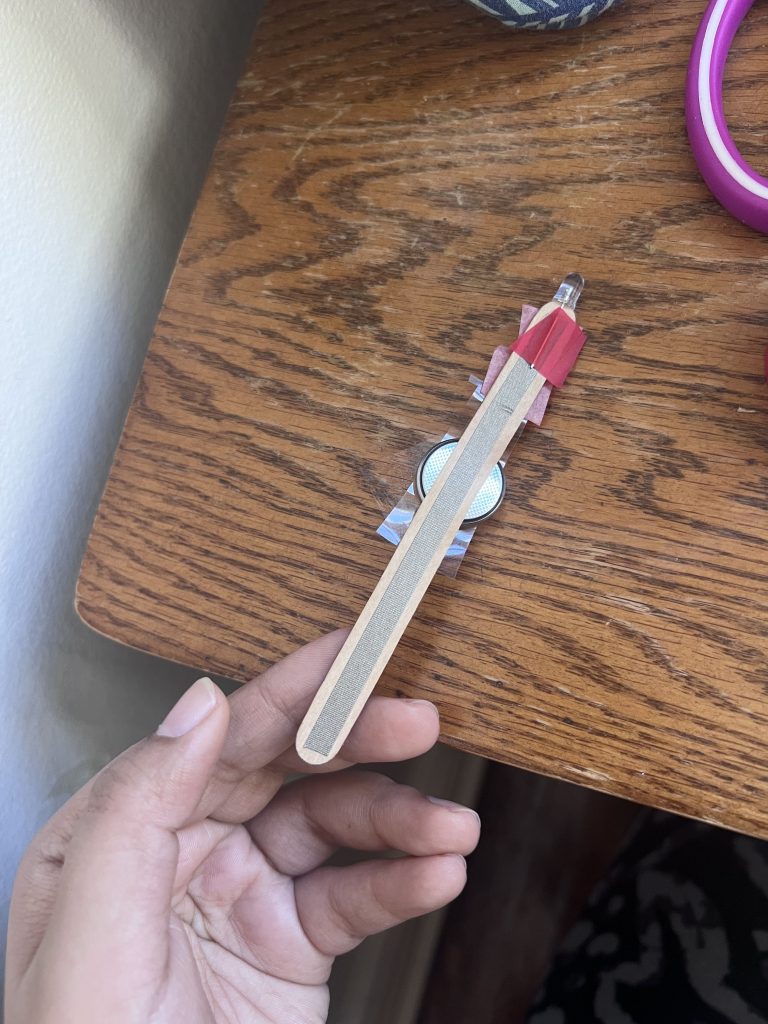
- Testing the Circuit: a. Now we will test the circuit by placing the stick in the stainless steel brush and if it lights up, then our glowing flower is already ready!
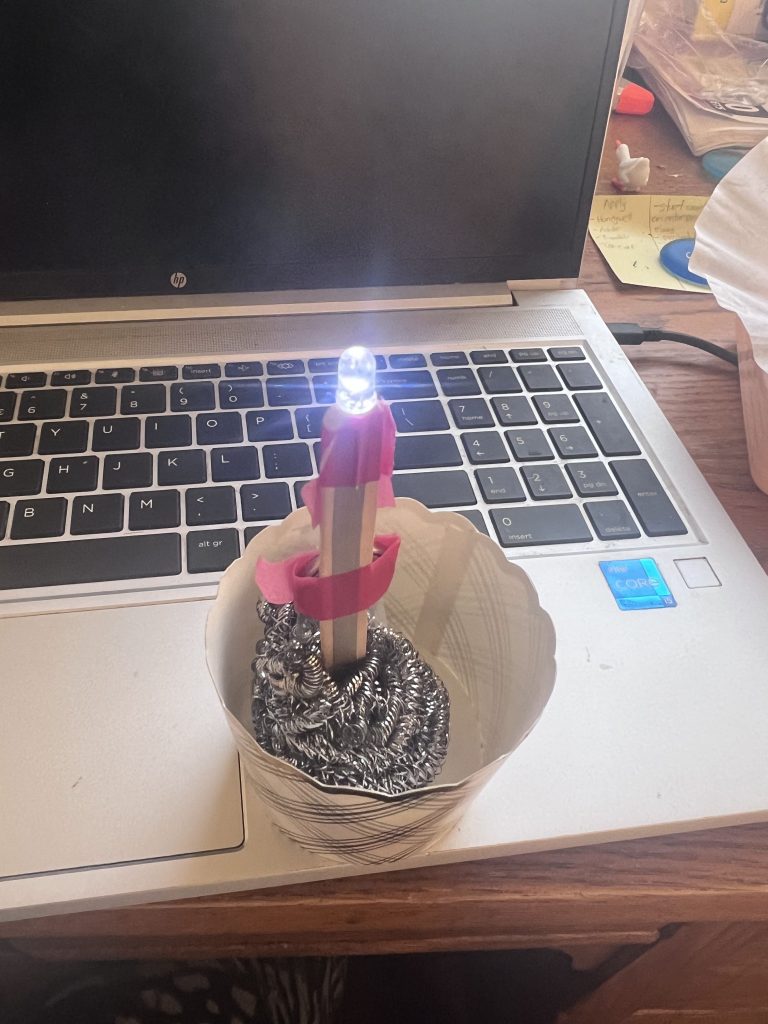
b. After the LED lights up, we will put in the cupcake holder altogether and will move onto the next step.
c. Now we will move onto making the flower petals. There are various ways of decorating the flower petals. But I went with the most simple way and just draped a coffee filter over the glowing light to create. Below is the result of my work:
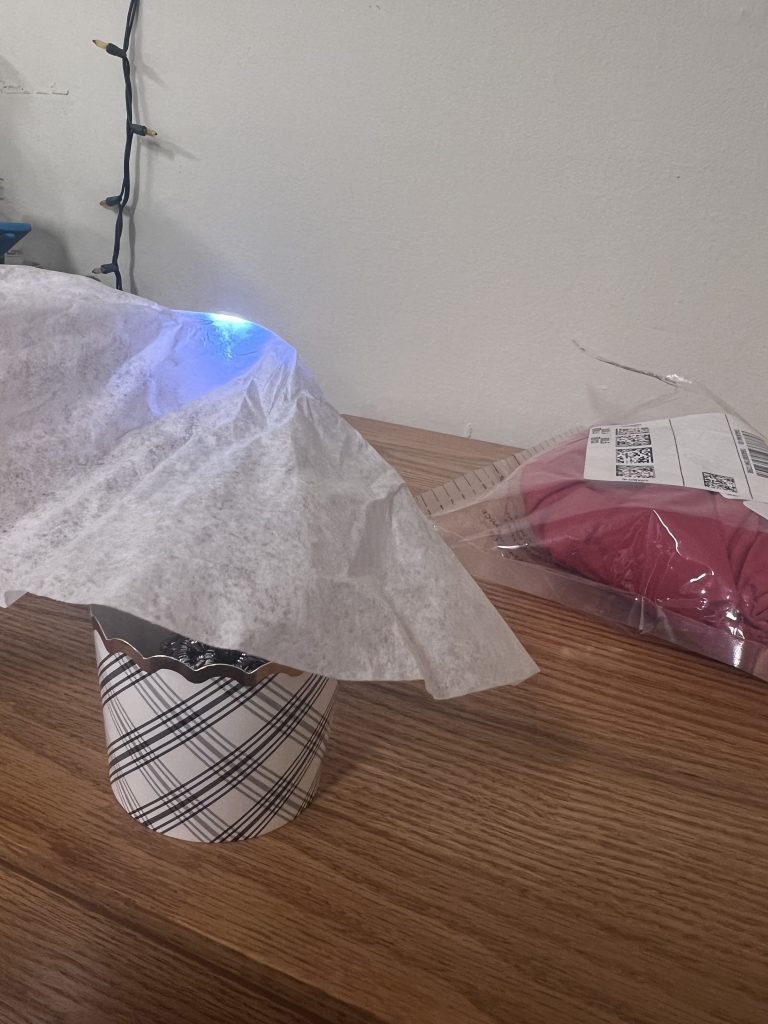
d. Here’s a short video of the glowing flower pot:
Reflection
- Reflect back on the project experience and how it relates to the topics of self-efficacy and mindset, using the prompts below. You can choose a written format (1-2 paragraphs) or recorded video/audio (1-3 minutes).
The project is a fun project that revolves around creating a glowing flower pot using led and implements the basic concept of simple circuit. We all have more or less grown up with learning the basics of circuit design in physics. I’ve had my fair share of learning different variations of circuit drawing and implementing them on paper. But I never got the chance to actually create a circuit on my own and implement it. Looking back on my self-efficacy, on most technical project my efficacy on myself starts low as I can’t trust myself fully to actually complete it. This mindset often causes me to lose faith in myself and stumble more than how many times I was supposed to. So my confidence level for the project initially wasn’t strong enough and I was prepared to face off the worst. However when the concept of simple circuit was introduced in the class and we made the cute bracelet using led lights and a simple circuit board, I was enthralled with the process. I was over the moon as I was finally seeing all of this happening in real life when throughout my whole life I’ve read about them but never tried on my own. With this newfound confidence and belief in myself, I was ecstatic to get started on this project and had complete faith in myself to execute it on my own.
When I started the project I was on a good path and everything was going great until my LED light after all the steps wasn’t lighting. I started to panic as this wasn’t expected. I nervously went through the entire slides to see if I missed anything but when I tightly pressed the light to the conductive tape and put it on the copper, it worked! I couldn’t believe I actually debugged it on my own and completed the project! It changed my perspective on self-efficacy and self-confidence on how having complete faith and believing in myself helped me complete something that I thought was impossible. It taught me how self-efficacy can change our behavior pattern and it might seem not to work the first few times, but it will definitely work the next time.
- Choose one of the 6 tech projects from below and consider creating a comparable project in this class. What role are self-efficacy and mindset playing in your reaction to them? You can choose a written format (1-2 paragraphs) or recorded video/audio (1-3 minutes).
As a fashion-lover from childhood who grew up watching Zac Posen’s iconic glass dress and having none around me who can relate to what I was so fascinated with, I was immediately drawn to the Robotic Spider Dress(project-3 on the web). While I don’t even know where to start to make this, the prospect of it makes me excited! Embarking on a complex project like creating a robotic spider dress with LED lights as a beginner is both exciting and challenging, requiring a blend of self-efficacy and a growth-oriented mindset. Self-efficacy, which is belief in your ability to accomplish specific tasks, is vital here. Developing and sustaining high self-efficacy will shape how I approach each step of this project, from understanding basic robotics to implementing LED lighting systems. Since you are new to the technical aspects, having self-efficacy helps you tackle initial difficulties without feeling discouraged. For instance, if a circuit malfunctions or if coding doesn’t work as planned, my self-efficacy will give me the confidence to think, “I can solve this,” and encourage me to seek solutions. This belief in my capabilities can transform daunting challenges into opportunities to learn and grow, driving me to acquire skills and refine design incrementally.
A growth mindset, which is the belief that skills and intelligence can be developed through hard work, effort, and learning from mistakes, is equally essential. Robotics and electronics often involve trial and error, where initial designs may fail or yield unexpected results. With a growth mindset, you’re likely to see these setbacks as natural parts of the learning process rather than as evidence of any fixed limitations. For instance, if I accidently misconnect an LED, a growth mindset will allow me to reflect, troubleshoot, and adapt another approach. Embracing the learning curve in this way allows for steady progress, as every failure becomes an opportunity to improve and refine both technical abilities and creative vision.
Together, self-efficacy and a growth mindset empower us to face the uncertainties and complexities inherent in a robotics project. As we gradually develop competence in coding, electronics, and design, I will build momentum, which further strengthens self-efficacy. With each step forward, I’m close to building a foundation for tackling more advanced projects in the future, using the skills and confidence I’ve cultivated. These qualities aren’t just beneficial for this specific project but are essential tools in learning any new skill, helping us grow as a creator and problem-solve.
3. Challenge yourself to step back and think about any parallels you can draw to your learning journey at large, using the prompts below. You can choose a written format (2-4 paragraphs) or recorded video/audio (2-5 minutes).
Reflecting on my seventh-grade experience with debate reminds me of how self-efficacy—or lack thereof—can influence our choices. I was incredibly interested in debating and nearly joined the debate club, imagining myself engaged in dynamic discussions and honing my public speaking skills. But, in those early moments, I let doubts take over. I struggled to believe I could constructively debate and feared I’d lack the skill to formulate responses under pressure. My friends also added to this self-doubt, warning me that debating might become a burden and distract me from my studies. Their comments ultimately swayed me away, reinforcing my worries and pushing me to believe that maybe debate wasn’t the right fit.
In later grades, however, I watched peers actively participating in debates and regretted my decision. At that point, both debate teams were well-established, and it was difficult to join. I eventually found my way into public speaking and became an active voice, participating in competitions—even on international platforms. Yet, I often thought back to that pivotal seventh-grade moment and wondered what might have been if I had had more faith in myself back then. Looking back, it was my limited self-efficacy that held me back from pursuing an opportunity that aligned with my interests and skills.
If I could speak to my former self now, I’d encourage a change in mindset. I’d remind myself that stepping out of my comfort zone would be an essential part of growth, and that success in debating—or any other skill—often involves gradual improvement rather than instant perfection. I’d tell myself to embrace the challenge and acknowledge that any initial discomfort would pave the way for confidence over time. Now, I understand that self-efficacy isn’t about believing we’ll be perfect; it’s about trusting that we can learn and improve, a mindset I carry forward today.
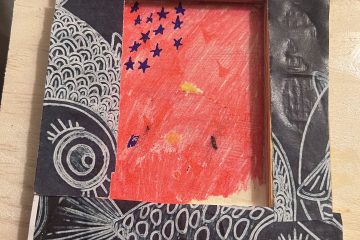
0 Comments